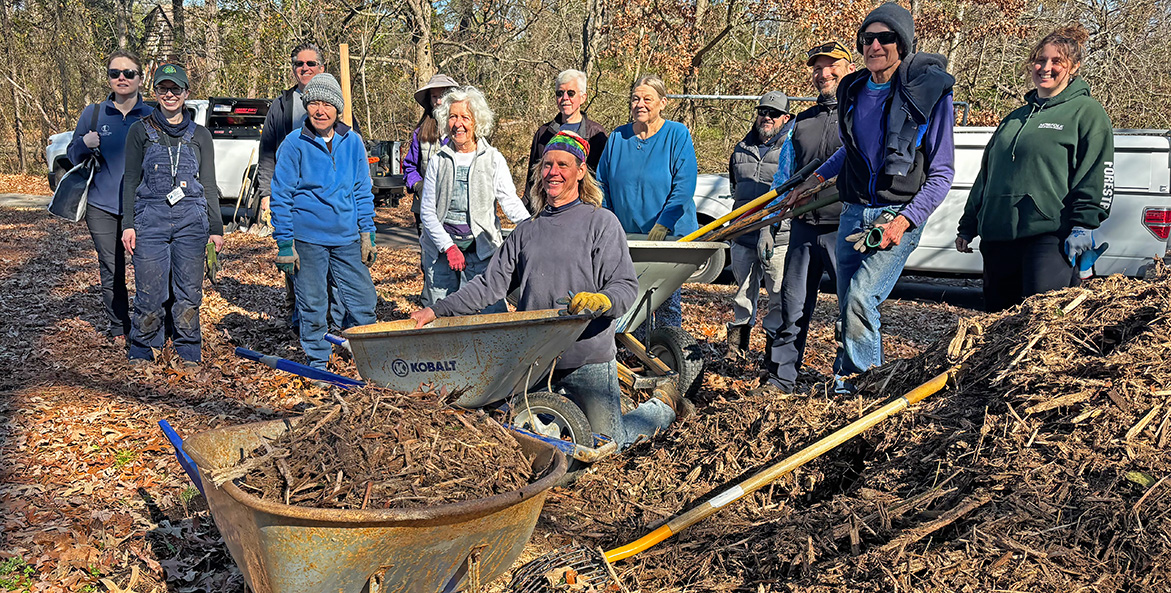From the banks of the stream running through Poplar Hall Park and into the Elizabeth River, Karen Cifranick could still hear the whine of 18-wheeler trucks and cars.
But the sound felt distant. Tucked behind some old growth trees and sprawling green space, Poplar Hall Park’s stream can make Interstate 264’s traffic—and the rest of Norfolk’s development—seem, at least a little, like a different world.
It’s a feeling Cifranick and other volunteers hoped to preserve as much as they could. With shovels in hand, 13 residents from around the region teamed up with CBF and the City of Norfolk to plant just over 41 native trees in the park earlier this month.
In the past decade, there's been an alarming loss of Virginia's tree canopy.
The sweet bay magnolias and little blue stems were chosen for their enhanced ability to prevent further erosion of the stream’s banks.
The volunteers’ work would be followed by two more tree plantings at Poplar Hall Park, all to aid in Norfolk’s push to increase its tree canopy from 23 percent to 30 percent. Over the years, Cifranick is one of many of the region’s residents who said she’s watched green spaces replaced by asphalt or multi-story buildings.
To look at a tree canopy map of the state, what she saw in her region’s backyard could be seen playing out across the Commonwealth.
In the past decade, there’s been an alarming loss of Virginia’s tree canopy. Development, hotter wildfires, road widenings, invasive species, and increased energy infrastructure have all threatened Virginia’s trees. In just four years between 2014 and 2018, the state lost a net 9,548 acres of urban and forest canopy.
And new satellite imagery is anticipated to only show an accelerated decrease.
That has ripple effects for communities and the state—especially as flash floods that overwhelm sewer systems and heat waves baking urban heat islands become more common.
Why Trees Are Critical to Our Communities and Environment
“Trees are ultimately about people. They do so much more than beautify neighborhoods,” Chesapeake Bay Foundation Virginia Director of Outreach and Advocacy Ann Jurczyk said. “Trees keep residents’ utility bills low, prevent their streets from flooding, and protect their backyard streams from erosion.”
Trees also give soil more time to absorb rainfall, filter pollutants, and prevent erosion. That makes them one of the most cost-effective ways to prevent polluted runoff from reaching waterways, protect streams, and alleviate floods.
A one-inch rainfall on a one-acre parking lot, for example, pours 27,154 gallons of water into low-lying areas and streams. In a forest, the same amount of rainfall produces only 750 gallons of runoff.
Trees also provide shade that cools neighborhoods and reduce energy use. On hot summer days, neighborhoods lacking trees become heat islands, which correlate to heat-related hospital visits. This raises environmental justice concerns since heat islands can be concentrated in formerly redlined areas.
Glimmers of Hope this General Assembly Session
In addition to launching tree planting efforts, localities like Norfolk have started to ask state lawmakers for more authority to not just replace trees that have been lost, but also save them before they’re cut down.
This General Assembly session, representatives have responded with a historic show of support. Though tree conservation bills have historically stalled in the House of Delegates, multiple bills are now successfully moving through the General Assembly.
Virginia’s tree loss is clearly trending in the wrong direction. This is a climate change and equity issue. Local leaders are asking for ways to expand their tree canopy so they can cost-effectively reduce flooding, manage stormwater, and reduce the health impacts of urban heat islands and air pollution for their residents.
HB 529, introduced by Del. Patrick Hope, would give localities broader authority to replace trees lost during construction. If passed into law, localities would have the authority to establish tree replacement requirements and establish a tree fund if trees can’t be replaced on site.
Another bill, HB 1100, introduced by Del. Betsy Carr, has to do with saving trees before they’re cut down rather than replacing them. It enables all localities to conserve more trees during development. Currently, only some Northern Virginia localities have the authority to adopt tree conservation ordinances.
Both these bills have passed the House and are being considered by the Senate.
Under another set of companion bills, conservation is also key. These bills enable localities to incentivize developers to conduct an assessment—before a site plan is submitted for approval—and take necessary precautions to preserve existing healthy trees. It also allows tree funds to be used for tree maintenance. These bills—HB 459 introduced by Del. Richard Sullivan and SB 121 introduced by Sen. Suhas Subramanyam—have both passed their respective chambers.
Lastly, HB 309 by Del. Patrick Hope and SB 461 by Sen. David Marsden would allow Virginia to determine how many acres of the Commonwealth’s forests are healthy, the cause behind the lost canopy acreage, how to reconnect forest fragments, and identify opportunities for further conservation efforts. HB 309 is now before the full House, and SB 461 passed the Senate unanimously.
CBF also has urged legislators to support a budget amendment that directs the Virginia Department of Transportation (VDOT) to study the loss of forest and urban tree canopy due to road construction and create a restoration plan.
Meanwhile, back at Poplar Hall Park after the tree planting, volunteers packed up their shovels and their gloves. Before they drove away, some watched dog owners walk the trails and children play along the water’s bank. The saplings wouldn’t solve the state’s problem of losing too many trees. But it served as a sign of hope.

Virginia Communications & Media Relations Manager, CBF
[email protected]
804-258-1567
Issues in this Post
Forest Loss Community Conservation Politics Restoration Trees CBF in Virginia



